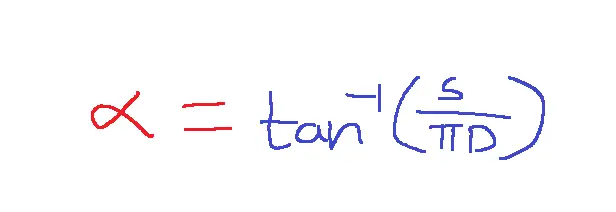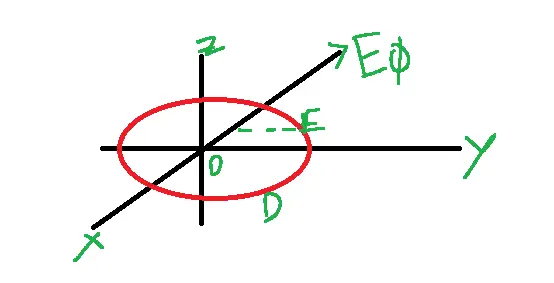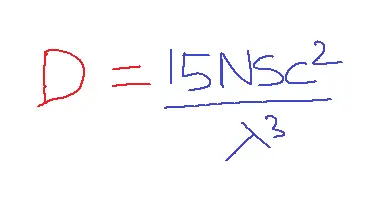- A Helical Antenna is the simplest antenna to provide a circularly polarized wave useful for HF, DHF, and UHF communications.
- A Helical Antenna is a broadband antenna useful for satellite communication, radar, and terrestrial communications.

- C is circumference
- n is the number of turns
- l- is the distance between the ground plane and the Helix
- α is the pitch angle
- a is axial length=n X s.
- If one turn of the helix is unrolled on a plain surface the circumference πd and turn length l and pitch angle α are related by a triangle as shown in the below pitch angle between the line tangent and the plane of the Helix normal to the axis.

Polarization and radiation are controlled by the thickness of the coil(d), as well as circumference(πd), diameter(d), pitch angle(α), and spacing(s).
Table of Contents
There are two modes of operation in Helical Antenna:
- Normal mode
- Axial mode
Normal Mode:
When the Helix is operated in the normal mode the radiation field is broadway. The dimensions of the helix are small compared to the wavelength.
Working:
By placing the Helix at the center of the spherical coordinate system the radiation pattern can be analyzed by the values of θ and π.

Design consideration:
A helical antenna consists of small loops and small dipoles connected in series.

The above formulas are the phase difference between the electric field components.
Therefore, the ratio of these two components provides the axial ratio.

If Ar is zero, it is a linear horizontal polarization. If Ar is infinity it is a linear vertical polarization.
Ar=1 is a circular polarization. A is the area of the loop.

Axial Mode of operation:
- The helical antenna can be operated in an actual mode during operation where the radiation direction is maximum along the axis of the array. This occurs where diameter and spacing are comparable to wavelength.
- The condition of the axial mode can be achieved by raising the circumference(c/lambda) to one wavelength and spacing between the elements is approximately lambda/4.
- A helical antenna’s broader bandwidth capability is facilitated by its side lobe levels ( minor lobes), which exist at oblique angles to the main beam.
- The helical antenna operated with the ground plane must be at least half the wavelength.
- The pitch angle α varies from 12 degrees to 18 degrees. The gain and directivity depend on the Helix length which provides a terminal impedance of 100 to 200 ohms within ±20% approximation.
The half-power beam width at θ=0 is given by

FNBW=2.21 X HPBW
Directivity is given by

Normal Axial ratio is given by E=sin(π/2N)cos|(sinNφ/2)/(sinφ/2)|
Axial ratio is defined as the ratio of θ component to ∅ the component of the electric field vector.
FAQs related to the topic
Q1. What is a helical antenna?
- A helical antenna is a radio antenna made of one or more conducting wires wound in a helix shape.
- Due to its ability to offer wide bandwidth, high directivity, and circular polarization, it is well-suited for applications including satellite communication and radio astronomy.
Q2. How does a helical antenna work?
- Helical antennas transmit and receive radio waves by generating an electromagnetic field along the helix’s length.
- The shape of the helix, along with its dimensions, determines the antenna’s radiation pattern and polarization characteristics.
Q3. What are the advantages of a helical antenna?
- Wide Bandwidth: Helical antennas can operate across a broad range of frequencies.
- Circular Polarization: Their ability to transmit and receive circularly polarized signals makes them less vulnerable to fading and multipath interference.
- High Directivity: Helical antennas can focus the radio waves in a specific direction, increasing signal strength and reducing interference.
- Simple Design: They are relatively easy to construct and have a simple mechanical structure.
Q4. What are the applications of a helical antenna?
Helical antennas are widely used in various applications, including:
- Satellite Communication: For tracking and communication with satellites.
- Radio Astronomy: For receiving signals from distant celestial objects.
- Telemetry: For transmitting data from remote sensors and devices.
- Wireless Communication Systems: For various wireless communication applications.
Q5. How do I design a helical antenna?
- Designing a helical antenna involves determining the helix’s dimensions (diameter, pitch, number of turns) based on the desired operating frequency, gain, and polarization.
- Several online resources and software tools can help with the design process.
Q6. What are the different modes of operation for a helical antenna?
Helical antennas have two primary modes of operation:
- Normal Mode: This mode is characterized by helix dimensions considerably smaller than the wavelength. The radiation pattern is broad, and the gain is relatively low.
- Axial Mode: This is the most common mode of operation for helical antennas. The circumference of the helix is approximately equal to the wavelength. The antenna’s radiation is highly focused along the helix axis, with a directional pattern that yields higher gain.
Q7. How does the number of turns in a helical antenna affect its performance?
- Increasing the number of turns in a helical antenna generally increases the antenna’s directivity and gain.
- However, it also increases the antenna’s size and complexity.
Q8. Can I build a helical antenna myself?
- Yes, you can build a helical antenna yourself. There are numerous online resources and tutorials available that provide step-by-step instructions and design guidelines.
- However, it’s important to accurately calculate the dimensions and carefully construct the antenna to ensure optimal performance.
